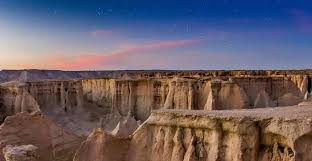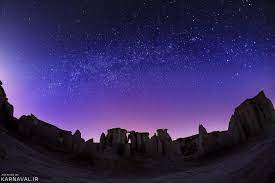فهرست مطالب
Introduction
Qeshm Island, the largest island in the Persian Gulf, is celebrated for its diverse natural wonders that attract nature enthusiasts and tourists alike. Among its most extraordinary features is the "Star Valley," a natural marvel that locals refer to as "Estar-e Kofta." Formed through the erosive actions of wind and water on soft rock formations, this valley presents a surreal, otherworldly landscape.

Origin and Formation History of Star Valley
Star Valley, located near Berkeh Khalaf village, is one of the most prominent geomorphological features of Qeshm Island. This valley is a testament to the long-term erosional processes acting upon sedimentary and sandstone layers with varying compositions.
The formation of Star Valley dates back to the Quaternary period of geological history, a time marked by climatic shifts and tectonic activity. The erosive action of flash floods, running water, and strong seasonal winds are key contributors to the formation of this valley, carving out its towering columns, deep gullies, and bizarre shapes.
Geomorphological Features of Star Valley
Star Valley is characterized by a complex array of stone columns, cones, fissures, and pits, creating a diverse geomorphological landscape. These structures are the result of the unique composition of rocks and soils in the area, coupled with the varying impacts of erosion and climate.
One of the valley’s most notable features is the presence of tall, slender stone pillars known as "hoodoos." Hoodoos are vertical rock formations created by differential erosion, where softer rock layers erode faster than the harder layers, leaving behind towering pillars.
The valley also hosts small caves and cavities formed by lateral erosion and sediment washing by surface waters. Some of these cavities are so deep that they have created underground passageways within the rock formations.

Local Legends and Beliefs
Star Valley has been the subject of numerous local legends and beliefs over the centuries. Some locals believe that the valley was formed by stars falling from the sky, giving rise to its name "Star Valley." This belief likely stems from the valley's unusual and otherworldly appearance, which makes it seem like part of a different realm or the result of a cosmic event.
Other local legends suggest that the valley is inhabited by spirits and jinns, with strange sounds emanating from within the valley at night. These beliefs have led some locals to avoid entering the valley after dark.

Scientific Studies and Geological Significance of Star Valley
Star Valley, as one of Iran's key natural and geological attractions, has drawn the attention of many geologists and researchers. Studies conducted in this valley indicate that differential erosion is the primary factor responsible for the unique structures in the region. This type of erosion causes different rock layers to wear away at different rates, creating complex and unusual formations.
Additionally, research has shown that the specific types of sedimentary rocks found in this valley, including sandstones and marls, have contributed to the rapid erosion compared to other regions. This makes Star Valley an exemplary case of erosional phenomena in arid and semi-arid environments.

Conservation and Tourism Importance of Star Valley
Given the geological and natural importance of Star Valley, the area has been recognized as one of Iran's key geoparks and is under protection. Promoting sustainable tourism in this area is a priority for both local and national authorities, as the valley is one of Qeshm's most important tourist attractions, drawing thousands of domestic and international visitors annually.
Various efforts have been made to protect the valley and prevent its degradation. These efforts include installing educational signs, restricting access to sensitive areas, and creating designated walking paths.

Conclusion
Star Valley in Qeshm is one of Iran's most unique natural and geological wonders, capturing the imagination with its strange rock formations and the local legends that surround it. This valley is not only a tourist attraction but also a natural laboratory for studying erosional and geological processes in arid and semi-arid regions. Protecting this valley and promoting sustainable tourism can help preserve this valuable natural heritage for future generations, ensuring that its beauty and scientific significance continue to be appreciated.
